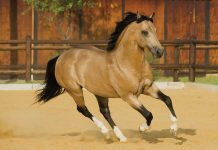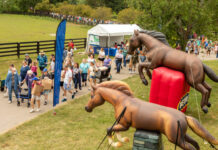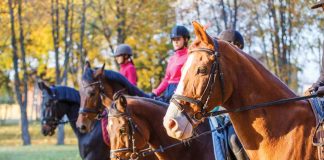
Let’s face it, everyone falls off sometimes. As you improve as a rider, you’ll be attempting more difficult horsey activities and it’s likely that you’ll “eat dirt” occasionally.
But remember, you can also fall off while out on a quiet trail ride if your horse stumbles or spooks at a “monster” behind a tree. That’s the thing about falling off—you never know when it might happen.
Let’s take a look at falling off and see what you can do to make hitting the ground less traumatic!
Safety Clothing
Safety gear can help you prevent a fall and protect you in case of one. The most important piece of safety gear is, of course, a helmet. Buy an ASTM/SEI (look for the label inside) approved helmet with a secure chin strap and wear it every time you get on a horse! Your brain is like soft Jell-O inside your skull—if you crack your skull and injure your brain you could suffer permanent brain damage.
Wear gloves. You have less chance of losing control of your horse if you have a firm grip on the reins. Riding in wet weather can cause slippery.
If you do a lot of jumping, invest in a body protector. They aren’t just for eventers! You can wear one when you jump in the ring or when you’re out on a trail. They’re lightweight and help to protect your internal organs if you fall off and hit something hard or if a horse kicks you.
Reasons For Falling Off
There are tons of reasons why you might fall off. We’ve listed a few of them and what you can do to lessen your chances of taking a tumble.
- Your horse trips on a trail or spooks and you tip off.
When you’re trail riding, stay alert and aware of your surroundings. Keep a fairly good hold on the reins and keep your legs on your horse’s side to keep him moving forward. He’s less likely to stumble if he’s walking forward at a brisk pace. - Your horse gets excited or is naughty and bucks you off.
When your horse gets excited, try your best to put him in a 20-meter circle and ask him to work. Do lots of transitions and try to keep his attention on you, not what’s going on around him. Keep fairly short reins and keep his head up a little higher than usual. He’ll find it hard to buck if his head isn’t on the ground. If he starts bucking, shorten your reins, lean back in the saddle, push your feet forward and give him a BIG kick to get him moving forward. - Your horse refuses a fence but you fly over it!
Be prepared before jumping. Warm up on the flat properly. Ease into jumping by popping over smaller fences first. Don’t over-face your horse and jump fences that are too high. Don’t lean too far forward in front of a fence. Rest your rear end lightly in the saddle and sit up straight. Push those heels down to give you more security in the saddle. - Your horse over-jumps a fence and throws you out of the saddle.
If your horse has a tendency to over-jump, lower your stirrups a hole and sit back a little deeper in the saddle. Don’t get into the traditional jumping position. You’re safer if you get slightly left behind, rather than getting thrown five feet out of the saddle! - Your horse stops or turns suddenly.
Try not to let your horse stop or turn without your permission. You should give him instructions—not the other way around! Ride with shorter reins and keep your legs on your horse’s sides at all times. Nudge him forward with your lower legs and ask him to work and listen to you.
The Actual Fall
Falling off can happen quickly. There’s not a lot of time to think! But here are a few things to try to remember as you’re flying through the air!
Let go of the reins. It’s a natural instinct to want to keep hold of the reins, but you could break an arm by doing this. Many horses put down their heads and graze after you fall, and if your mount runs off someone will catch him eventually. Broken reins are better than broken arms or wrists.
Bring your arms close to your body. Most hand and wrist injuries are caused by riders trying to break their fall by putting their arms out. It’s better to tuck up into a “ball” and land on your shoulder and then roll over. When you’re tucked up into a ball, you’re less likely to get stepped on and if you do, you might not get hurt so badly.
Practice Falling
It might sound silly, but you can practice falling off—preferably in a soft sand arena! Try tucking your chin to your chest, falling on your shoulder and rolling from a standing up position. Then be a bit more daring and take a gentle leap off a bucket!
After The Fall
Don’t hop up immediately if you feel dizzy or hurt. Lie still for a moment or two and get your breath back. Too often concussed riders will get up and chase after their horses. If you’re at a competition, someone will catch him. If you suspect that you’re injured, stay where you are and wait for help. Most shows have an emergency medical technician.
If you feel OK after a fall, stand up slowly and catch your horse. Make sure that he’s uninjured and check that his tack isn’t broken. Then you can remount.
Getting on after a fall is quite important. It’s easy to lose your nerve after hitting the ground hard. The best thing you can do is to hop back into the saddle and continue riding. Hopefully, both you and your horse will forget about the fall and get back to work.
Even if you’ve hurt your pride after a fall, don’t take it out on your horse. By the time you catch him, he’ll have forgotten what he did to deserve a smack. Mark the fall up to experience and move on.





